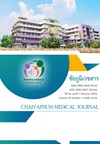การศึกษาการใช้ดิจิตอลแพลตฟอร์ม ที่ส่งผลต่อระยะเวลาส่งตัวมารักษาด้วยการขยายหลอดเลือดหัวใจในผู้ป่วยกล้ามเนื้อหัวใจขาดเลือดเฉียบพลันชนิดเอสทียกในจังหวัดชัยภูมิ
คำสำคัญ:
เวลาที่มาถึงโรงพยาบาล, กล้ามเนื้อหัวใจขาดเลือดฉับพลัน, การสวนหลอดเลือดหัวใจ, กูเกิลฟอร์มบทคัดย่อ
ความสำคัญและที่มา: ผู้ป่วยโรคกล้ามเนื้อหัวใจขาดเลือดเฉียบพลันชนิด ST-segment elevation myocardial infarction (STEMI) ต้องได้รับการรักษาอย่างรวดเร็ว ไม่ควรเกิน 60 นาที เพื่อลดอัตราการเสียชีวิต
วัตุประสงค์: เพื่อเปรียบเทียบระยะเวลาแต่ละขั้นตอนการรักษาผู้ป่วยกล้ามเนื้อหัวใจขาดเลือดเฉียบพลันชนิด ST-segment elevation ระหว่างการใช้ดิจิตอลแพลตฟอร์มกับการบันทึกด้วยมือ
วิธีการศึกษา: การศึกษาแบบภาคตัดขวาง (Cross-sectional study) จากข้อมูลทุติยภูมิในผู้ป่วย STEMI จำนวน 512 ราย แบ่งเป็นกลุ่มที่บันทึกด้วยมือ 243 ราย (พ.ย.64 - ต.ค.65) และกลุ่มที่บันทึกด้วยดิจิตอลแพลตฟอร์ม (Google form) 269 ราย (พ.ย.65 - ต.ค.66) โดยเก็บข้อมูลเริ่มจากเข้ารับบริการจนถึงการยืนยันการวินิจฉัย รวม 6 ขั้นตอน วิเคราะห์ข้อมูลด้วยสถิติ Repeated measure ANOVA
ผลการศึกษา: กลุ่มตัวอย่างที่บันทึกข้อมูลด้วยมือ ใช้เวลาเฉลี่ยในการบันทึกข้อมูล 162.20 นาที ส่วนกลุ่มที่บันทึกด้วย Google form ใช้เวลาเฉลี่ย 150.92 นาที ทั้งนี้ การบันทึกด้วยมือใช้เวลาสูงสุดในขั้นตอนการยืนยันการวินิจฉัยจนถึงการส่งต่อเพื่อสวนหลอดเลือดหัวใจแบบปฐมภูมิ (81.26 นาที; 95% CI: 75.83, 86.69) รองลงมา คือ ขั้นตอนการทำ EKG จนถึงการวินิจฉัย (47.70 นาที; 95% CI: 42.28, 53.13) เช่นเดียวกับ การบันทึกด้วย Google form ใช้เวลา 61.92 นาที (95% CI: 56.76, 67.07) และ 22.02 นาที (95% CI: 16.86, 27.17) ตามลำดับ ในภาพรวม การบันทึกด้วย Google form ใช้เวลาน้อยกว่าการบันทึกด้วยมืออย่างมีนัยสำคัญทางสถิติ (p-value < 0.001) โดยขั้นตอนที่มีความแตกต่างกันสูงสุด คือ การทำ EKG จนถึงการวินิจฉัย (Mean diff.= 25.69; 95% CI: 18.20, 33.17) รองลงมา คือ การยืนยันการวินิจฉัยจนถึงการส่งเต่อเพื่อสวนหลอดเลือดหัวใจแบบปฐมภูมิ (Mean diff. = 19.34; 95% CI: 11.85, 26.82) และพบว่า ขั้นตอนการเข้ารับบริการจนถึงการทำ EKG ในสองวิธีการ ไม่แตกต่างกันทางสถิติ (Mean diff.= 4.91; 95% CI: -2.57, 12.39)
สรุป: การพัฒนาดิจิตอลแพลตฟอร์มสามารถลดระยะเวลาในการรับบริการในผู้ป่วยโรคหัวใจขาดเลือดฉับพลันได้ อย่างไรก็ตาม วิธีการดังกล่าวยังไม่บรรลุเป้าหมายที่ควรจะเป็น (< 60 นาที) การพัฒนาต่อยอดด้วยการลดกระบวนการที่ไม่จำเป็นและการเชื่อมต่ออุปกรณ์เข้ากับระบบดิจิตอลแพลตฟอร์ม เป็นแนวทางที่ควรส่งเสริมในอนาคต
เอกสารอ้างอิง
Srimahachota S, Boonyaratavej S, Kanjanavanit R, Sritara P, Krittayaphong R, Kunjara-Na-Ayudhya R, et al. Thai Registry in Acute Coronary Syndrome (TRACS) -an extension of Thai Acute Coronary Syndrome Registry (TACS) group: lower in-hospital but still high mortality at one-year. J Med Assoc Thai 2012; 95(4):508-18.
Ibanez B, James S, Agewall S, Antunes MJ, Bucciarelli-Ducci C, Bueno H, et al. 2017 ESC Guidelines for the management of acute myocardial infarction in patients presenting with ST-segment elevation: The Task Force for the management of acute myocardial infarction in patients presenting with ST-segment elevation of the European Society of Cardiology (ESC). Eur Heart J 2018;39(2):119-77.
Mohan B, Bansal R, Dogra N, Sharma S, Chopra A, Varma S, et al. Factors influencing prehospital delay in patients presenting with ST-elevation myocardial infarction and the impact of prehospital electrocardiogram. Indian Heart J 2018;70(Suppl 3):S194–8.
Aitavarra-Anttila MK, Pernu HH, Rumpunen TK, Similä JPO, Liisanantti JH, Kaakinenet TI, al. Factors associated with time delay to angiography in acute ST-elevation myocardial infarction – a retrospective cohort study in northern Finland. Australas Emerg Care 2022; 25(3):213– 8.
Swaminathan RV, Wang TY, Kaltenbach LA, Kim LK, Minutello RM, Bergman G, et al. Nonsystem reasons for delay in door-to-balloon time and associated in-hospital mortality: a report from the national cardiovascular data registry. J Am Coll Cardiol 2013;61(16):1688– 95.
Terkelsen CJ, Sørensen JT, Maeng M, Jensen LO, Tilsted HH, Trautner S, et al. System delay and mortality among patients with STEMI treated with primary percutaneous coronary intervention. JAMA 2010;304(7):763–71.
Nielsen PH, Terkelsen CJ, Nielsen TT, Thuesen L, Krusell LR, Thayssen P, et al. System delay and timing of intervention in acute myocardial infarction (from the Danish Acute Myocardial Infarction-2 [DANAMI-2] Trial). Am J Cardiol 2011;108(6):776–81.
Bryan RT, Kristy BG, Jose PP, Michelangelo LS ,Gregorio SM. System Delays and Target Points: An Analysis of the ST-elevation MI Response Programme in a Single Centre. JAPSP 2023;2:e27.
Bryn E, James E, Simon A, Michael C, Deborah B. Association Between Hospital Practices and Door-in-door-out Time in ST-segment Elevation Myocardial Infarction. Crit Pathw Cardiol 2016;15(4):165–8.
Wang TY, Nallamothu BK, Krumholz HM, Li S, Roe MT, Jollis JG, et al. Association of Door-In to Door-Out Time With Reperfusion Delays and Outcomes Among Patients Transferred for Primary Percutaneous Coronary Intervention. JAMA 2011;305(24):2540-7.
Oumin S, Khan AM, Rezai MR, Jackevicius CA, Cox J, Atzema CL, et al. Factors associated with door-in to door-out delays among ST-segment elevation myocardial infarction (STEMI) patients transferred for primary percutaneous coronary intervention: a population-based cohort study in Ontario, Canada. BMC Cardiovascular Disorders 2018;18(1):204.
Khowaja S, Ahmed S, Kumar R, Shah JA, Khan KA, Khan NU, et al. Time to think beyond door to balloon time: significance of total ischemic time in STEMI. Egypt Heart J 2021;73(1):95.
Yiadom MY AB, Olubowale OO, Jenkins CA, Miller KF, West JL, Vogus TJ, et al. Understanding timely STEMI treatment performance: A 3-year retrospective cohort study using diagnosis-to-balloon-time and care subintervals. J Am Coll Emerg Physicians Open 2021;2(1):e12379.
Kang GK, Zhang H, Zhou J, Wan D. The Effectiveness of the Smartphone-Based WeChat Platform on Reducing Time to Diagnosis and Treatment of ST-segment Elevation Myocardial Infarction. Cardiovasc Med 2023;24(12):374
McNamara RL, Wang Y, Herrin J, Curtis JP, Bradley EH, Magid DJ, et al. Effect of door-to-balloon time on mortality in patients with ST-segment elevation myocardial infarction. J Am Coll Cardiol 2006;47(11):2180-6.
Gibson CM, Pride YB, Frederick PD, Pollack CV, Canto JG, Tiefenbrunn AJ, et al. Trends in reperfusion strategies, door to-needle and door-to-balloon times, and in-hospital mortality among patients with ST-segment elevation myocardial infarction enrolled in the National Registry of Myocardial Infarction from 1990 to 2006. Am Heart J 2008;156(6):1035-44.
Mehta RH, Bufalino VJ, Pan W, Hernandez AF, Cannon CP, Fonarow GC, et al. Achieving rapid reperfusion with primary percutaneous coronary intervention remains a challenge: insights from American Heart Association’s Get With the Guidelines program. Am Heart J 2008;155(6):1059-67.
Bagai A, Al-Khalidi HR, Muñoz D, Monk L, Roettig ML, Corbett CC, et al. Bypassing the emergency department and time to reperfusion in patients with prehospital ST-segment-elevation: findings from the reperfusion in acute myocardial infarction in Carolina Emergency Departments project. Circ Cardiovasc Interv 2013;6(4):399-406.
Dauerman HL, Bates ER, Kontos MC, Li S, Garvey JL, Henry TD, et al. Nationwide Analysis of Patients With ST-Segment Elevation Myocardial Infarction Transferred for Primary Percutaneous Intervention: Findings From the American Heart Association Mission: Lifeline Program. Circ Cardiovasc Interv 2015;8(5):e002450.
ดาวน์โหลด
เผยแพร่แล้ว
ฉบับ
บท
การอนุญาต
ลิขสิทธิ์ (c) 2024 ชัยภูมิเวชสาร

This work is licensed under a Creative Commons Attribution-NonCommercial-NoDerivatives 4.0 International License.





